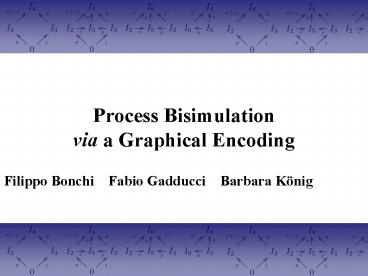Process Bisimulation via a Graphical Encoding - PowerPoint PPT Presentation
1 / 58
Title:
Process Bisimulation via a Graphical Encoding
Description:
via a Graphical Encoding. Filippo Bonchi Fabio Gadducci Barbara K nig. Leifer and Milner's Theory of Reactive System. Given a reduction systems, ... – PowerPoint PPT presentation
Number of Views:72
Avg rating:3.0/5.0
Title: Process Bisimulation via a Graphical Encoding
1
Process Bisimulation via a Graphical Encoding
Filippo Bonchi Fabio Gadducci Barbara König
2
Leifer and Milners Theory of Reactive System
- Given a reduction systems,
- derive a labeled transition system
- where
- bisimilarity is a congruence
3
Borrowed Context Rewriting
Rewriting rules L?I?R DPO Rewriting Reduction
System BC Rewriting Labeled Transition System
4
From Process to Graph
Gadducci Montanari propose several encodings
of Process in Graph Correct and Complete w.r.t.
Structural Congruence Processes Reductions are
simulated by Graphs Rewrites
5
Our Approach
Processes
Graphs
Reduction Rules
Rewriting Rules
6
Our Approach
Processes
Graphs
Reduction Rules
Rewriting Rules
LTS Semantics
BC Rewriting
7
Plan of the Talk
- Two operational semantics for CCS
- From Processes to Graphs with Interfaces
- From Process Reductions
- to DPO Graph Rewrites
- Borrowed Contexts Rewritings
- Conclusions
8
Plan of the Talk
- Two operational semantics for CCS
- From Processes to Graphs with Interfaces
- From Process Reductions
- to DPO Graph Rewrites
- Borrowed Contexts Rewritings
- Conclusions
9
CCS Syntax
A process is a term where each occurence of a
variable x is in the scope of a recx
10
Reduction Semantics
The reduction is closed under the Structural
Congruence
11
Interactive Semantics
12
Two Operational Semantics
- Reduction Semantics
- Reduction System Structural Congruence
- Specify how the whole system behaves
- More natural and easy
- Trivial behavioral equivalence
- Interactive Semantics
- Labeled Transition System
- labels are interactions and observations
- Specify how the system interact with the
envoirment - More expressive
- Good behavioral equivalence
13
Plan of the Talk
- Two operational semantics for CCS
- From Processes to Graphs with Interfaces
- From Process Reductions
- to DPO Graph Rewrites
- Borrowed Contexts Rewritings
- Conclusions
14
Graphs with Interfaces
- J?G?K
A process is a graph Ø?G?K, where K contains all
the free name of the process Graphs K?G?K are
contexts where processes can be inserted
15
The encoding
summations
processes
names
(for label op either snd or rcv)
16
Sequential Process
17
Parallel Process
18
Non Deterministic Process
19
Restriced Process
20
A Context
21
Interaction with The Environment
22
Interaction with The Environment
23
Interaction with The Environment
24
Interaction with The Environment
The process cannot interact on a since it is not
in the interface
25
Plan of the Talk
- Two operational semantics for CCS
- From Processes to Graphs with Interfaces
- From Process Reductions
- to DPO Graph Rewrites
- Borrowed Contexts Rewritings
- Conclusions
26
DPO rewriting on Graph with Interface
- Productions are span
27
DPO rewriting on Graph with Interface
- Productions are span
- Find a match m of L inside G
28
DPO rewriting on Graph with Interface
- Productions are span
- Find a match m of L inside G
- Construct C such that (1) is a pushout and k
exists
29
DPO rewriting on Graph with Interface
- Productions are span
- Find a match m of L inside G
- Construct C such that (1) is a pushout and k
exists - Construct H such that (2) is a pushout
30
The synchronization rule
31
The internal action rule
32
Example
33
Example
34
Example
35
Example
36
Plan of the Talk
- Two operational semantics for CCS
- From Processes to Graphs with Interfaces
- From Process Reductions
- to DPO Graph Rewrites
- Borrowed Contexts Rewritings
- Conclusions
37
Borrowed Context Rewriting
38
Borrowed Context Rewriting
39
Borrowed Context Rewriting
40
Borrowed Context Rewriting
41
Example
42
(No Transcript)
43
(No Transcript)
44
(No Transcript)
45
(No Transcript)
46
(No Transcript)
47
(No Transcript)
48
(No Transcript)
49
(No Transcript)
50
(No Transcript)
51
(No Transcript)
52
(No Transcript)
53
Plan of the Talk
- Two operational semantics for CCS
- From Processes to Graphs with Interfaces
- From Process Reductions
- to DPO Graph Rewrites
- Borrowed Contexts Rewritings
- Conclusions
54
The synthetized LTS
- It is finite branching
- It is really close to the standard
- Bisimilarity coincides with the standard
55
CCS encoding in Bigraphs
- Infinite rules
- Infinite branching LTS
- Only finite processes
- Bisimilarity is finer than the standard
56
However
- Reasoning on a such LTS is really hard
- This approach works badly for calculi with
scoping
57
Future Works
- Define a rule format for describing the labeled
transitions of a graph - Find adhesive structure to encode calculi with
scoping
58
Gadducci Montanari Approach
Process
Graphs
Reduction Rules
Rewriting Rules
Reduction Semantics
DPO Rewriting































